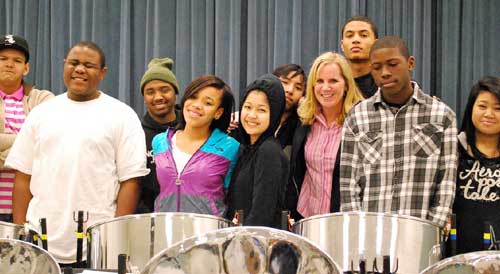 |
|||
| College of Education Home | News & Events | Make a Gift | UW Alumni | |||
|
April 2011 | Return to issue home
Jennifer Wiley: Franklin High Principal Leads by Example By Elizabeth Lowry
Education Career path Research Background About Franklin High School
Turning point On why she chose the UW for graduate study Her story When she rose to address the 259 graduating seniors, she assured them she was not wearing the purple of Franklin’s rival high school. She was wearing Husky purple because she, too, had graduated that very weekend with her doctorate in education from the University of Washington. She wanted to show her students that if she could be the first in her family to go to college and ultimately earn her doctorate, so could they. Like her students, Jennifer Wiley has traveled a long, challenging road to where she is. At first glance, it’s hard to imagine what Jennifer, a tall, slender blonde, has in common with her students. Of Franklin’s 1,301 students, 96 percent are students of color: 53 percent Asian, 34 percent black, 7 percent Hispanic and 1 percent Native American. Only 4 percent of the students—57, to be exact—are white. The school has the highest number of bilingual students—14 percent—among Seattle high schools. Of all students, 69 percent qualify for free or reduced lunch, the highest number of any high school in Seattle Public Schools. And yet, 88 percent of the 2009 graduating Franklin class reported they were heading to four- and two-year colleges. "Dr. Wiley is real," said Scott Griggs, an intervention specialist who works with at-risk youth at Franklin. Griggs has earned three degrees from the UW: his bachelor’s degree in art, his master’s degree in teaching and his master of education degree in intercollegiate sports leadership. "She delivers it straight to the kids. She delivers it straight to the teachers. You may not always like what she has to say, but she’s honest." Griggs said the kids respect her for it. They connect with her because they know she’s genuine, and they sense her drive to make a difference. Jennifer remembers the sting of being an outsider in high school, as a needs-based scholarship student who didn’t come from a family with money. Although she thrived in high school and then in college academically, it was not lost on her that she did not have some of the same privileges, preparation and opportunities as many of her peers. "She can talk the kids’ language without trying to sound like them," he said. Franklin’s culture, Scott said, is one that accepts students for who they are, and Jennifer sets the tone. For example, Franklin’s lion dancers—who wear lion costumes and perform traditional Chinese dances—include Asian and black students. To further connect with students and continue to hone her teaching skills, Jennifer teaches a steel drum class. An accomplished percussionist, she handpicked students from several groups and grade levels to participate—with hope that the kids would bond and build community across groups of kids. "I’m a basketball player, and when I first came in here in my gym suit, nobody else was in a gym suit. Nobody was talking about basketball. The teacher was the principal, and I thought it’s gonna be a long year," Anddrew Hawkins, a junior, said. But within a short time, the students said, they quickly became like family. "It’s the best example of pure learning you can find,” Griggs said, noting that none of the students came to the class with drumming experience and very few could even read music. Within four months, the steel drum class had a playlist of five songs, including Dynamite, by Taio Cruz, and I Got a Feeling, by The Black Eyed Peas, alongside traditional Trinidadian music. Jennifer’s educational philosophy comes directly from her own life experience. Growing up in an unstable home in which her parents never even discussed college, Jennifer found refuge at school, where all students were expected to go on to higher education. "If you don’t have the generational momentum, you really don’t know what is going on in education," Jennifer said. "I personally was the beneficiary of private schooling thanks to the graciousness and social justice agenda of the Jesuits. I really benefited in so many ways by powerful teachers and a powerful education." It’s that positive environment with high expectations that Jennifer—and the faculty and staff—strive to recreate at Franklin. "A public school can be every bit as powerful and potent as a private school but without the second-class citizenry," she said. "When students come across the threshold of a schoolhouse, all things are possible. Good education should never be left to chance for our young people. We ought to make it a national priority to secure the very best experiences for every child in the U.S." Jennifer readily admits that not all of Franklin’s students will go to college, and that it’s not necessarily the right choice for everyone. But, she wants to make sure that every student who graduates has the choice. * Photo by Elizabeth Lowry April 2011 | Return to issue home | |||
|
|||
